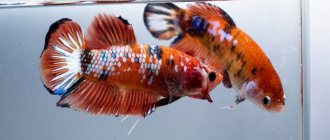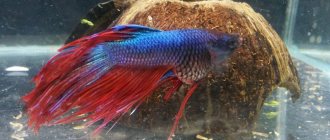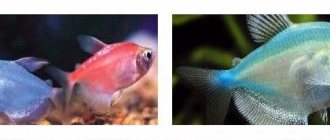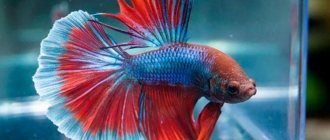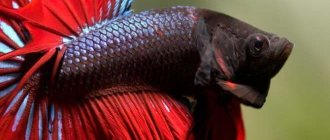The betta (betta, Siamese betta) is a favorite among aquarium fish breeders. Bright color, lush tail and chic fins, lively disposition - all this justifies the name of the species. And the relative ease of keeping and breeding has made these aquarium inhabitants very popular. The fish is famous for its aggression towards other representatives of its species, for which it is called a fighting fish.
In the article we will look at the cockerel fish, the female and male of which have the following differences. Traditionally, the male is brighter and larger. Other visually detectable sexual characteristics are less noticeable and require careful examination of the fish.
General information about betta fish
Betta splendens is Latin for "fighting fish" or "Siamese cockerel". This fish is a representative of the macropod family. The name “betta fish” was given due to the pugnacious nature of the males, intolerant of each other, but not aggressive towards most other species of fish. Seeing another male, the cockerel is ready to fight to the death. For this property, fish were used for spectacular performances - “fish cockfights” in Asian countries. Female bettas also often “don’t get along” with each other. Fortunately, today “fish fights” are officially prohibited and calm times have come for the fish in home aquariums.
An aquarium fish called "betta" or "betta" is popular among aquarists. The main feature of this species is the respiratory organ, which is called the “labyrinth”. It consists of plates abundantly penetrated with blood vessels. Located inside the accessory epibranchial plane. Air captured from the surface accumulates in this cavity, which is used sparingly as needed. Thus, with the help of the labyrinth, fish can breathe atmospheric air. This type of breathing is essential for bettas. The “labyrinth” is a kind of “lifeline” for survival in various bodies of water, where the oxygen level is quite low, which can lead to large-scale death of many species of fish.
The lifespan of a betta fish greatly depends on the conditions in the aquarium. As a rule, they live no more than 3 years. For breeding, it is worth choosing fish at the age of 3–4 months. At this age, males do not yet have the luxurious fins that older fish have, but they are very active, and females reach puberty at this age. If an old female does not spawn at a young age, the eggs degenerate, the genital opening becomes blocked, and the female becomes unable to spawn.
The size of male Siamese cockerels reaches up to 6 cm, and females - up to 4 cm. The fins located on the chest have a pointed shape, and those located on the back and in the tail are rounded. In females, all fins are less developed than in males. Males that have already bred have longer fins.
The color of wild bettas can be olive or slightly gray; dark stripes in fish can run along or across the entire body. Males become even more beautiful during spawning or when fighting with other males. When excited or during a fight, male bettas protrude their gill covers in the form of a collar. In this state they are very similar to real roosters. The females of this type of fish have a somewhat pale color and not very large fins. Although sometimes there are females that have elongated fins and coloring that makes them very similar to males.
Wild Betta
To date, breeders have been able to develop more than 70 breeds of such fish, differing in color and shape of fins. Male cockerels have no equal in brightness and variety of colors! There are red, pink, blue, yellow, green colors. This is especially noticeable in bright lighting, where the small body plays and shimmers in various shades. At the same time, the transitions of these colors look catchy and impressive.
The breeds of fighting fish bred by modern breeders are among the most colorful and beautiful aquarium inhabitants of all the remaining representatives of their own species.
Differences between males and females
With good care, such pets can live from 2 to 3 years and grow up to 6-7 centimeters in length. Sexual differences between males and females in betta fish are pronounced. Males are larger than the fairer sex and have brighter and larger fins. In addition, a female betta can be identified by a white speck located near the anal fin. This is an ovipositor that appears during spawning.
Cockerels live 2-3 years
The differences between male and female bettas are worth considering in more detail, since this important information will be useful when keeping fish and breeding them. It is worth noting that it is quite easy to distinguish them, since the sexual characteristics of representatives of the Betta genus appear quite clearly.
These include:
- body size and structure;
- behavioral characteristics;
- shape and size of fins.
You need to understand that the differences between females and males of different species have their own criteria, which are important to take into account when examining pets. Also, some signs depend on the age of the fish and the phase of their life.
Looking at the fish, you can see that the fins of males are longer and larger than those of females. This criterion is considered the main one when determining sex, but it is not applicable if the aquarist’s pond contains short-tailed cockerels. In this case, you will again have to pay attention to the fins, but only to the anal ones. So, in boys they are elongated and elongated, and in girls they are short and rounded.
As already noted, adult females have an ovipositor in the shape of a small star just in front of the anus. But small fish do not yet have this feature, so this feature should not be considered when buying teenagers. https://www.youtube.com/embed/q7TGybQLpvk
Before spawning, the body of dark-colored females is covered with vertical stripes to warn the males that they are ready to mate. But the scales of light-colored girls do not change their color, so this criterion is not applicable to them. However, upon careful examination of the females, you can notice that eggs are visible through their body.
Also, when determining gender, you should pay attention to the shape of the fish. Males are flexible and slender (their body tapers towards the tail and thickens closer to the head), while females are dense and stocky, and have a relief curve in the front part of the belly - this is where the caviar is located.
The differences in behavioral characteristics of male and female betta fish are quite ambiguous. Young girls, when in good health and development, can behave as aggressively as boys, especially during spawning:
- they arrange fights among themselves;
- show each other threatening poses, straightening their fins and protruding their gill covers.
If teenage roosters behave cockily and aggressively, you should not mistake them for males. You need to take a closer look at the fish and look for other signs of sexual differences. Only after this will it be possible to confirm or refute the first impression.
Variations in breeding forms and colors of betta fish
The color and shape of the fins are the main differences between artificially bred breeds of bettas and representatives of the “wild” type living in natural bodies of water. Based on these differences, uniform standards were invented for all modern breeders and amateur fish breeders.
By fin shape and size:
- Half-moon Betta (Halfmoon Betta)
- Crowntail Betta
- Veiltail Betta
- Doubletail Betta
- Round-tailed fighting fish
- Spadetail Betta - Speartail
- Flag-tailed betta fish
- Plakat betta fish (with a short tail fin, but long others, English Plakat Betta)
- Delta-tailed fighting fish (with fins spread, like the emblem of an airline - a flying plane, English Deltatail)
- Giant or royal fighting fish (larger in size, but still with short fins, English: King Betta;
By color:
- Single color (blue, purple, green, red, orange, black, white, yellow, cream)
- Bicolor (body is one color and fins and/or fin tips are another)
- Multicolor “multicolor” (the body and fins are of different colors, and the fins can have several transitional color shades: from light to dark and vice versa; there are fish with a dark head and front part of the back, and the rest is much lighter)
Breeders have separately identified a breed of fighting fish called “dragon”. Its representatives have a more massive body, which is predominantly silver-metallic in color interspersed with various color shades, incl. contrasting. Such representatives of fighting fish are classified as poster type.
betta dragon
What is the difference between a female and a male?
Sexual differences in betta fish are clearly visible. The body of males is slender, brightly colored, with long fins. The female is usually smaller and has shorter fins. At the 3rd month of life, a small light speck appears on her abdomen.
Origin of the betta fish
The appearance of the first mentions of these fish can be dated back to 1800, since it was during this period that the attention of the local residents of Siam (modern Thailand) was attracted by small fish that showed aggression towards each other. Individuals of the “brawlers” were distinguished by short fins and a not particularly attractive dark body color. For some time, the inhabitants of Siam crossed wild “fighters” and eventually got a new species called “biting fish” (Pla Kat).
These fighting fish were assigned to the genus Macropodus in his manuscripts by the naturalist and part-time Danish physician T. Cantor, after he was given several unique and especially valuable specimens of betta fish by the King of Siam in 1840. And in 1909, the world famous ichthyologist C. Tate gave this species a new name Betta splendens.
The first fighting fish arrived in Paris in 1892, and in Germany four years later. Fourteen years later, in 1910, the Siamese cockerel was able to appear in the United States of America, thanks to F. Locke from San Francisco (California). During the selection, he was able to develop a new color color, previously not inherent in this species.
The appearance of betta in Russia is associated with several versions. According to one of them, the famous aquarist of the 19th century, V. Desnitsky, back in 1896, brought exotic species of plants and fish from Singapore, but there is no confirmation anywhere that there were cockerels among them.
According to another version, at approximately the same time period, amateur aquarist V. Melnikov carried out the process of breeding the first labyrinth fish in Russia, and in honor of this discoverer, much later, a competition was formed to present the best betta fish.
According to the third version, betta fish came to Russian territory with the help of the Frenchman G. Seyselem, and from the offspring of these fish, representatives of not only Russian, but also European betta fish appeared.
The Council of Ministers of Thailand on February 5, 2021 was able to confirm that their national aquatic animal is the Siamese fighting fish.
The most colorful aquarium fish
A novice aquarist may have a question: why keep these quarrelsome, cocky cockerels? They can fight among themselves, offend other fish and jump out of the aquarium...
Despite its slightly problematic behavior, the betta is one of the most popular fish in home aquariums. Their aggressive behavior can be corrected by choosing the right neighbors and providing the fish with the necessary shelters.
And the fantastic beauty of aquarium cockerels, the richest range of colors and absolute unpretentiousness to living conditions rightfully make them the favorites of many aquarists.
Habitat of the betta fish
Asia, in particular its southeastern part, is considered the homeland of the betta fish, since it is in the stagnant and slowly flowing reservoirs of Vietnam, Indonesia, Laos, Thailand and Cambodia that one can often find nondescript “wild” representatives of this species. Bettas are found everywhere in the turbid, oxygen-poor waters of rice fields, and even in the drains of large cities. Survival in such extreme conditions becomes possible thanks to an additional respiratory organ - the “labyrinth”.
Behavior of female bettas
Over many years of selective breeding, bettas were bred as fighting fish, so males with the most aggressive character were selected. The cocky individuals were used for fighting, which is now considered illegal.
Although the females are less vicious, they can still stand up for themselves. These fish have a craving for hierarchy and protect their territory. Fights may occur, but they are less severe than in males and rarely result in injury. Aggression is usually directed at other bettas; these fish are calm towards the rest of the aquarium inhabitants.
These are slow swimmers that inhabit the upper and lower layers of water. Sometimes you can see them rise to the surface and swallow air. This is due to the presence of a labyrinth apparatus used for breathing. They have gills, but if there is little oxygen in the water, the fish often rise to the surface.
Conditions for keeping betta fish
The betta fish does not require special care - even a five-liter jar is enough for one individual, but it must be equipped with at least a filter, and since this is impossible to do in small volumes, the optimal aquarium for a betta is 10 liters, which will accommodate the necessary equipment and Scenery. For several fish you will need a larger aquarium.
For normal keeping of betta fish, the water temperature should be within 25-28 degrees. If the temperature in the container is about 22 degrees, the fish will immediately sink to the bottom and will try to “burrow” into the soil or into the roots of aquarium plants. After this, the fish will begin the so-called hibernation state. As soon as the temperature in the aquarium begins to rise, the fish will instantly be able to wake up and head to the surface of the water.
Water hardness should not exceed 15 degrees, acidity 7.5 units.
There is no need to aerate the aquarium. If the height of the water column is more than 15 cm, then aeration is needed to ensure that warmer surface water mixes with cooler bottom water.
Filtration for bettas, as well as for other types of fish, is mandatory, because... thanks to it, mechanical and biological purification of water is carried out, helping to establish and maintain bio-balance in the aquarium.
Siamese bettas really like dense vegetation, but it is necessary to leave free areas so that the fish can swim unhindered. If artificial vegetation is installed on the bottom of the aquarium, it is necessary to remove sharp edges on it, which could become a source of injury to the delicate fins.
A dark color is best for primer. Against such a background, the cockerels in the aquarium will look very impressive and contrasting.
It is best to keep females in a group, but separated from the male, since they are in the process of establishing a hierarchy, during which there may be clashes between the introduced fish.
There should only be a single male. But if the aquarium has a significant area and there is a large amount of vegetation in it, then two males will be able to “get along” in this territory until one of them encroaches on the territorial boundaries of the other. In order to avoid unnecessary hassles, the easiest way is to put a plastic partition with holes in the aquarium.
Every week in aquariums it is necessary to change up to 30 percent of the water volume, and in the case of keeping fish in small aquariums, this manipulation should be done at least three times a week.
Features of reproduction
Breeding betta fish at home is a fairly simple task. It is enough to have a couple of different-sex individuals, as well as an idea of the reproductive characteristics of these inhabitants of the aquarium.
Conditions and requirements for water in the spawning area:
- the water temperature should be about 27 degrees;
- Water pH 6.7 – 7.3;
- a separate aquarium-spawning ground (the one where the fish feed is not suitable, because food residues worsen the quality of the water).
To get healthy and beautiful offspring when growing you need:
- choose the right pair of fish;
- prepare a spawning area with shelter for the female and plants that will help the male build a nest;
- stock up on food for the fry in advance.
Preparation and formation of pairs
If the purpose of reproduction is not selection, then choosing a pair is quite simple:
- two individuals of different sexes will be required;
- age from 5 – 6 months to 1.5 years;
- the fish should not differ greatly in size and color.
Preparing the couple:
- a couple of weeks before spawning, future producers must be separated by transplanting into different containers;
- at this time the couple should be well fed, preferably with live food;
- It is better to place aquariums with future parents nearby in order to accustom the fish to the neighborhood.
Preparing the spawning area
To breed bettas in an aquarium, you will have to prepare a spawning ground. This can be any transparent container with a capacity of 15 - 20 liters, necessarily equipped with a heater. Other auxiliary devices, such as a filter or compressor, may not be installed in the temporary home. But small algae floating on the surface of the water will be very useful; they will help the male in creating a nest. At the bottom of the spawning area it would be nice to build a shelter for the female, where she could hide from an overly temperamental “suitor”. Soil is not needed in the spawning area; it can prevent a caring father from collecting drowned eggs in the nest.
Important! Food for future fry is prepared in advance. The easiest way to grow the simplest ones is the slipper ciliates. To do this, take a jar of water (about 2 liters), add a little milk (one teaspoon) and a small piece of dried banana peel, 1 cm2 in size. After some time, the water will become lighter and it will be possible to see groups of protozoa in it. The food is ready!
Spawning
You can watch how betta fish reproduce for hours; this process looks like a theatrical performance. A most interesting spectacle! First, the future parent arranges a nest for the eggs: he swallows air bubbles and releases them in the place that he has designated as the “cradle”. It turns out to be a foamy cloud where the fry will grow and develop for the first time.
When spawning time approaches, the male begins his fierce ritual dance. He chases the female around the aquarium, striking her and thereby causing tension in the ovipositor. When the “egg” on the female’s abdomen noticeably enlarges, she demonstrates it to the male, and he, in turn, tightly clasps the female with his body, squeezing out the eggs and at the same time releasing milt. Upon completion of spawning, the caring father collects the eggs in the nest, and it is better to immediately place the exhausted female in a separate aquarium.
Caring for fry
The number of eggs in the nest reaches 600 pieces! Initially, they are milky white in color and elongated in shape, but within a day they greatly increase in size and become rounded. The male does not stop caring for his offspring: he constantly “repairs” the nest, which is trying to collapse, collects and returns drowning eggs to their place. A day later, larvae begin to appear from the eggs, which constantly drown, forcing the busy father to return them to the nest again and again.
Another day will pass, and the stronger fry will spread throughout the spawning area. By this time, the cockerel is already pretty exhausted from caring for the family, but still makes attempts to gather everyone in the nest, albeit with less enthusiasm. Its color fades. This is a signal that it is time to transfer the male to another container and feed him. Its function is completed. On average, 3 days pass from spawning to relative independence of the fry.
Feeding
Babies should be fed from day one. The ideal food for fry is ciliates. If you are unable to grow protozoa, you can purchase special microfeeds at pet stores. Young fish should be able to eat at any time!
Conditions
The housing for the fry must be equipped with a compressor, otherwise the fish will suffocate and die. The filter cannot be used, because... babies will not yet be able to resist the flow of water. You can gradually lower the water temperature in the aquarium with young animals, down to room temperature. If the fry eat live food, then you don’t have to change the water. If microfeeds are used, then a partial replacement is made daily (initially 4/5 parts per day, but as the fry grow, the volume of replaced water decreases).
After 2 weeks, the fish will be able to eat microworms and microplankton, and after another week - crushed tubifex. You can gradually increase the water level in the aquarium, and it can now be replaced by ½ part per day. At the age of 3 weeks, the fish must be transplanted into a spacious housing (about 100 liters) so that they can all grow and develop normally.
Feeding the betta fish
Wild representatives of this species are very unpretentious. They can eat almost anything that is the right size for such small fish: mosquito larvae, worms or other insects and small fish. Because Their natural habitat has limited resources; the fish don’t have much choice.
Suitable food for adult bettas can be dry (granulated and flake food, specialized food for this type of fish), frozen or live food (brine shrimp, bloodworms, tubifex, coretra, daphnia, cyclops). You should feed the fish no more than twice a day. The food should be eaten within a few minutes. Remember the important rule of all aquarists: it is better to underfeed than to overfeed!
Adults cannot be constantly fed high-protein foods, otherwise they will become obese, which will lead to a decline in immunity, followed by death.
Bettas need to have fasting days once a week, when the fish can eat everything they find in the aquarium.
Compatibility
The species is well suited for keeping with many fish.
It definitely doesn’t need to be kept with fish that like to cut off their fins, such as dwarf tetradons.
However, he himself can do the same, so he should not be kept with veiled species. WITH
They sometimes attack other fish, but this is a mistake in identification, apparently mistaking them for their relatives.
What you definitely shouldn’t do is put two males in the same aquarium, as they will definitely fight. Females are less aggressive, although they still have a strict hierarchy. One male can be kept with several females, provided that the aquarium has enough hiding places for the latter.
Speckled catfish, cardinals, acanthophthalmus, and viviparous fish will be good neighbors.
Betta fish - betta and its compatibility with other inhabitants of the aquarium
If the fish have a cocky character, this does not mean that they need to be completely isolated from other inhabitants of the aquarium. But it is worth considering that predatory fish can bite the long fins of cockerels, and the cockerels themselves can attack their neighbors. There are the following groups of fish with which bettas can and should not be placed with:
The cockerel gets along well with:
- viviparous poeciliids;
- corridors;
- ancistrus;
- thorns;
- rasborami;
- iris;
The cockerel gets along with:
- barbs;
- scalars;
- neon;
- minors;
But do not forget that these types of fish can nibble the fins of bettas.
The battlehouse will not be able to get along with:
- large cichlids;
- piranhas;
- tetraodons;
- goldfish;
- all large fish, as well as predatory and territorial species;
It is better not to introduce fish that are too small. Sometimes a cockerel can attack a guppy, confusing the fish with its relative due to its bright color. In order to be able to keep betta fish with other species, it is necessary to acquire an impressively sized aquarium.
When you first introduce fish into a common container, you must constantly monitor the behavior of the inhabitants of the aquarium. In the event of an attack by other “tenants,” it is necessary to place the cockerel in a separate container for a while.
It is not recommended to keep betta fish in the vicinity of other fish that have veil fins or very bright colors, as this can cause an attack of aggression in the betta.
The behavior of females, on the contrary, is characterized by restraint and conflicts with new neighbors are quite rare.
Fish that prefer the same warm water will feel comfortable in the same container with the bettas.
What types of betta fish are there?
About 70 species of fighting fish are already known. Representatives of each species have an individual, unusually bright color. All the variety of species is divided according to the shape and size of the fins and the nature of the color.
According to the shape and size of the fins, bettas are veiled-tailed, half-moon-tailed, crown-tailed, double-tailed, round-tailed, delta-tailed, brush-tailed, flag-tailed, poster-tailed and royal.
Based on color, cockerels are classified into single-color, two-color, and multi-color cockerels.
Let's look at the most famous species.
Veiled cockerel
The veiled cockerel (Betta splendens VT) is the very first variant bred by breeders. This variety became the ancestor of all known today. Fish of this species have a gorgeous flowing tail fin.
Crescent cockerel
The Crescent Cockerel (Betta splendens HM) is a fish with a large veiled tail, the side rays of which rotate 180 degrees. The fins on the chest, back and near the anus are just as long and lush. The body color of specimens of this species is two-colored with a very bright fin on the tail.
The following types of this type are derived:
The half-moon cockerel (Betta splendens CTHM) is the result of hybridization between the half-moon and the crown-tail.
Feathertail cockerel (Betta splendens Feathertail) – the tail rays of such specimens branch out.
Rosetail cockerel (Betta splendens RT) – the rays of the tail of this fish intertwine, forming chic ruffles.
Crown-tailed cockerel
The crown-tailed cockerel (Betta splendens CT) is the owner of a luxurious tail that is like a royal crown. The outermost caudal rays protrude beyond its limits, and the partition between them may be interrupted.
There are three types of such cockerels:
Single Rays have single tail rays;
Double Ray – double tail rays;
Multi Cross Ray – the rays of the tail are crossed.
Two-tailed cockerel
Double-tailed cockerel (Betta splendens DT) - the name of the fish indicates that its tail at the base is divided into two parts.
Brush-tailed cockerel
Brush-tailed cockerel (Betta splendens ST) - its tail has an original shape, similar to a flat brush, a tongue of flame from a fire or the tip of a spear.
Cockerel poster
The poster cockerel, also known as the short-tailed cockerel (Betta splendens PK), is a hybrid form that is distinguished by short fins on the back and tail. The caudal fin is wider than it is long. The English name for this species, Pla Kat, translates to “biting fish.” A type of poster betta with dissected fin tips is called a crowntail.
Delta Cockerel
The Delta cockerel (Betta splendens D) is similar in appearance to the veiled betta, but this species has rigid tail rays that form a wide isosceles triangle when moving (this looks like the Latin letter “delta”). The outer tail beams can rotate at an angle of 130 degrees.
Other types of Betta fish
Large-mouthed Siamese cockerel
As is obvious from the name, it differs in the size of its mouth from its relatives and in the smaller fins of both females and males;
Betta smarogda
Or the green cockerel - the most peaceful of its relatives. The appearance is ordinary - small fins, color from dark olive to brown.
Spawning of my cockerels:
First spawning of cockerels
11/13/12 spawning
11/16/12 the larvae hatched (temperature in the room is 25 degrees)
11/19/12 the fry began to swim, I dropped off the dad
Second spawning of cockerels
11/30/12 spawning
03.12.12 larvae
12/04/12 I set to hatch artemia eggs (3 tablespoons of salt without top per 1.5 liter bottle of water)
12/05/12 the fry swam, dropped off the dad, first feeding with yolk
12/06/12 first feeding of nauprias. Some of the fry perked up.
12/10/12 nauplii began to die
Betta fish feeding
Despite the fact that these fish can eat anything, they should be fed with special food and strictly 2 times a day. You should not hope that a well-fed rooster will refuse to eat. These beauties are not at all concerned about their figure; they are too gluttonous and can overeat to the point of death.
The fish's diet should consist of ready-made granulated food, and natural food - frozen bloodworms, crustaceans. Aquarium snails are a good choice of natural foods; cockerels eat them with pleasure. Pelleted feed should be purchased in special stores. Quite a few companies already produce food only for cockerels.
Such granules include a balanced content of protein and plant base. Feeds for fry have been developed. There are vitamin supplements to enhance color. In addition, there is a rich assortment with various components. That is, all the nutritional needs of the fish are taken into account, the owner can only choose the appropriate food and check the expiration date.
Diseases and prevention
Yes, “chickens” are hardy, and in nature they can live calmly in very dirty bodies of water. But this does not mean that you can turn an aquarium into a swamp. The water must be changed promptly, algal growth must be removed from the walls, and the filter must be washed to remove contaminants.
All fish get sick, and chickens are no exception. Diseases will thrive in a dirty aquarium. Outbreaks of bacterial diseases such as fin rot are especially common. You can also bring the infection with new inhabitants or used aquarium equipment.
Fish's wounds can become infected, but this happens much less often in female bettas than in males because they are less prone to bloody fights.
If the fish gets sick, you should transplant it into a quarantine aquarium in order to prevent the spread of the disease or protect it from intrusive neighbors. Medicines for bacterial infections can be purchased at most pet stores.
Bloating is also a fairly common problem in labyrinth fish. They begin to float up on their sides or belly up, and stop taking food. In this case, you should put your pet on a hunger strike for several days or give him a tiny piece of boiled green peas skewered on a toothpick.
Green peas help clear the intestines of fish from constipation.
The main cause of this problem is overfeeding. Try not to overfeed your bettas and give them a variety of foods. If the fish is prone to inflammation of the bladder, then it is recommended to refrain from dry food.
Breeding crowntails
For successful breeding, the selected pair of fish must reach 8 months of age. For these purposes, a separate aquarium with a volume of no more than 10 liters is allocated to the male and female. The optimal water temperature is +27°C. Additionally, you need to put a bunch of water moss in the aquarium, which has been thoroughly washed beforehand. After the fish move to the spawning area, it is important to feed them with high quality and complete food (for example, with tubifex and bloodworms).
- The male is in charge of the nest, and it is during “construction” work that he can be especially aggressive. To prevent the female from getting injured, it is better to separate the fish with a partition: this way they will see each other, but the male will not be able to cause harm. And when the nest is ready, remove the partition and the female will begin laying eggs.
- The male will pick up the eggs that fall to the bottom and independently place them in the nest. In some cases, the female helps him. The process takes about 3-4 hours, then the female should be removed from the aquarium (otherwise the male may begin to attack her).
The crowntail is so pugnacious that it can “fight” its own reflection in the glass until it completely loses its strength.
The larvae will appear in the nest in 2-3 days. Over the next 4 days they will turn into fry. Until the fry learns to swim around the aquarium, the male must be removed!
Usually reproduction is successful. But not always. Failure can occur if the most beautiful male, the owner of a huge bushy tail, is chosen for breeding. This approach is hardly correct: the strongest, most active and youngest male is best suited for the role of breeder.
Description
The closest relative of this fish is a macropod. The cockerel is similar in body shape: an elongated oval, slightly flattened on the sides. The main advantage that always attracts the attention of others is, of course, the fins. Their differences in shape, size, and color gave rise to the classification of cockerels.
Together with the lush “plumage”, the length of the fish is 4-5 cm. Large forms of betta fish reach sizes of 8 cm. In nature, Betta fish do not have such a variety of colors; olive and greenish shades predominate on their body. But breeders have achieved the appearance of different colors in aquarium specimens.
The labyrinth organ helps the cockerels survive in conditions of severe lack of oxygen, so they can be kept for a long time in very small containers.

